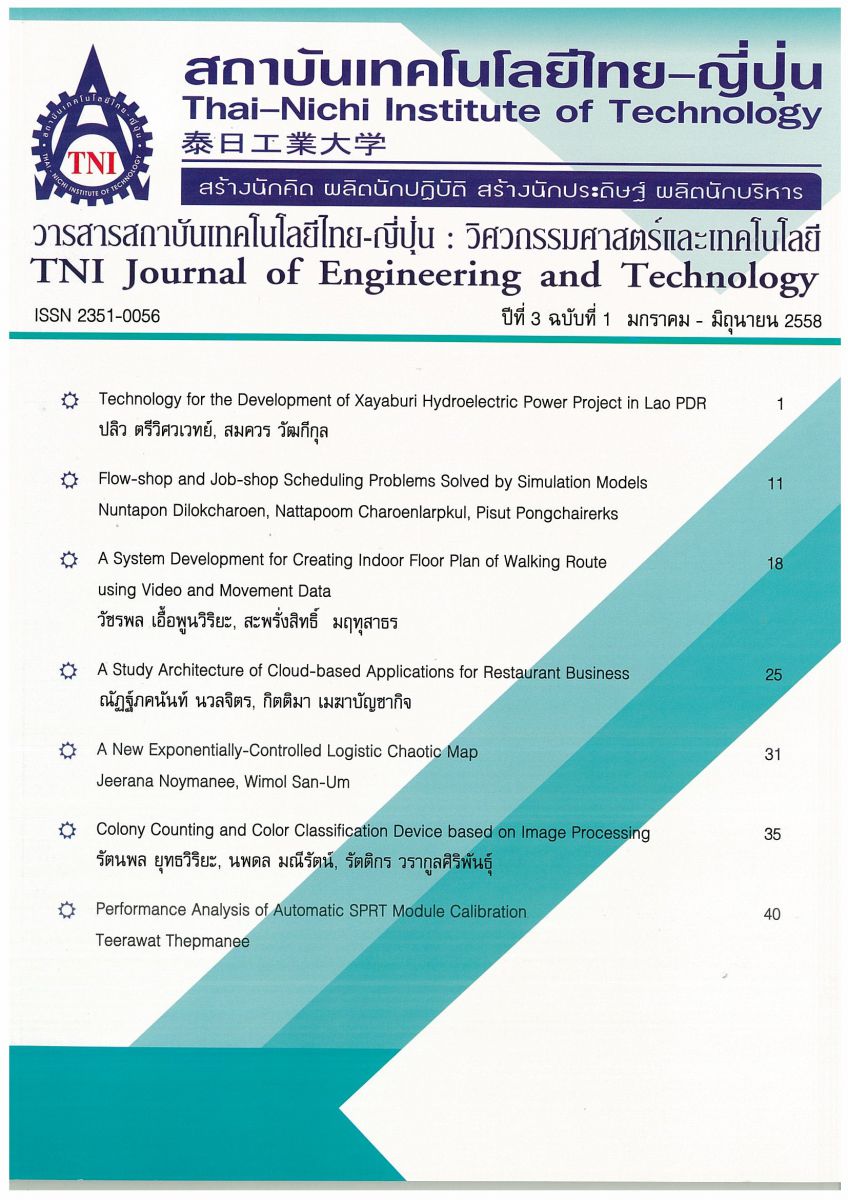A System Development for Creating Indoor Floor Plan of Walking Route using Video and Movement Data
Main Article Content
Abstract
In this research, system development for creating indoor floor plans based on the actual walking route of a person using an Android application on a smartphone working with a PC-based application on a PC has been proposed. Via a smartphone, the Android application is used for capturing indoor video and also obtaining various movement data from many types of mobile sensors e.g. accelerometer, gyroscope, etc., however, except for GPS due to the possibility of signal blocking and insufficient accuracy for the indoor purpose. Then all the collected data are sent to the PC to analyze and process using the PC-Based application to detect the edge between the floor and the wall from video and merge into a consolidated floor plan. In addition, the collected movement data is calculated and estimate the actual walking distance used for adjusting scale to correspond with the actual floor plan, which the complete floor plan of actual walking route is finally generated.
Article Details
Article Accepting Policy
The editorial board of Thai-Nichi Institute of Technology is pleased to receive articles from lecturers and experts in the fields of engineering and technology written in Thai or English. The academic work submitted for publication must not be published in any other publication before and must not be under consideration of other journal submissions. Therefore, those interested in participating in the dissemination of work and knowledge can submit their article to the editorial board for further submission to the screening committee to consider publishing in the journal. The articles that can be published include solely research articles. Interested persons can prepare their articles by reviewing recommendations for article authors.
Copyright infringement is solely the responsibility of the author(s) of the article. Articles that have been published must be screened and reviewed for quality from qualified experts approved by the editorial board.
The text that appears within each article published in this research journal is a personal opinion of each author, nothing related to Thai-Nichi Institute of Technology, and other faculty members in the institution in any way. Responsibilities and accuracy for the content of each article are owned by each author. If there is any mistake, each author will be responsible for his/her own article(s).
The editorial board reserves the right not to bring any content, views or comments of articles in the Journal of Thai-Nichi Institute of Technology to publish before receiving permission from the authorized author(s) in writing. The published work is the copyright of the Journal of Thai-Nichi Institute of Technology.
References
“GPS.gov: GPS Accuracy.” [Online]. Available: https://www.gps.gov/systems/gps/performance/accuracy/.[Accessed: 28-Dec-2014].
E. Wise, B. Li, T. Gallagher, A. Dempster, C. Rizos, E. Ramsey-Stewart, and D. Woo, “Indoor navigation for the blind and vision impaired: Where are we and where are we going?,” in 2012 International Conference on Indoor Positioning and Indoor Navigation (IPIN), 2012, pp. 1–7.
N. Fallah, I. Apostolopoulos, K. Bekris, and E. Folmer, “The User As a Sensor: Navigating Users with Visual Impairments in Indoor Spaces Using Tactile Landmarks,” in Proceedings of the SIGCHI Conference on Human Factors in Computing Systems, New York, NY, USA, 2012, pp. 425–432.
V. Euapoonviriya and S. Mruetusatorn, “A New Method of Generating the Indoor Floor Plan of Walking Route using Sequential Images and Movement Data Analysis and Processing,” presented at the ICBIR 2014 International Conference on Business and Industrial Research, 2014, pp. 215–217.
H. Shin, Y. Chon, and H. Cha, “Unsupervised Construction of an Indoor Floor Plan Using a Smartphone,” IEEE Trans. Syst. Man Cybern. Part C Appl. Rev., vol. 42, no. 6, pp. 889–898, Nov. 2012.
A. Sankar and S. Seitz, “Capturing Indoor Scenes with Smartphones,” in Proceedings of the 25th Annual ACM Symposium on User Interface Software and Technology, New York, NY, USA, 2012, pp. 403–412.
“Motion Sensors | Android Developers.” [Online]. Available: https://developer.android.com/guide/topics/sensors/sensors_motion. html#sensors-motion-stepcounter. [Accessed: 28-Dec-2014].
Y. Li and S. T. Birchfield, “Image-based segmentation of indoor corridor floors for a mobile robot,” in 2010 IEEE/RSJ International Conference on Intelligent Robots and Systems (IROS), 2010, pp. 837–843.
G. C. Barcelo, G. Panahandeh, and M. Jansson, “Image-based floor segmentation in visual inertial navigation,” in Instrumentation and Measurement Technology Conference (I2MTC), 2013 IEEE International, 2013, pp. 1402–1407.
W.-Y. Shih, L.-Y. Chen, and K.-C. Lan, “Estimating Walking Distance with a Smart Phone,” in 2012 Fifth International Symposium on Parallel Architectures, Algorithms and Programming (PAAP), 2012, pp. 166–171.
J. Goodwin, Touch & Movement: Palpation and Kinesiology for Massage Therapists. Cengage Learning, 2012.


